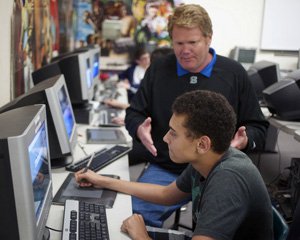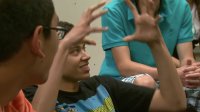Career Technical Classes: Preparing Tomorrow’s Skilled Professionals
Learning trade skills without losing sight of college.
There was a lot for Jeff Merker to be happy about on the last Tuesday of the school year. His shop class at Sheldon High School, in Elk Grove, California, was a hub of activity, not just kids talking and signing yearbooks, but actual productive stuff. In the shop yard outside the classroom, sparks sputtered as a student in a welding mask shored up metal table legs. Fifty feet away, a saw blade poked through a shed wall, cutting a door opening large enough for the small tractor that would be housed inside. But the best sounds Merker may have heard that day came from inside the class, where senior Eric Lucas-Jasso shouted, "Mr. Merker, it works!"
Lucas-Jasso had just plugged an electric guitar he made that semester into a small amplifier. Successfully turning two pieces of wood into a working instrument was as good as it gets for the 19-year-old senior who plans to study architecture in college. In four years at Sheldon, Lucas learned construction, carpentry, roofing, and engineering. He says this program and strong academics are the main reasons he came to Sheldon High, and they're the reason he's confident about heading to college. "It helps when you reach your goal of going to college to know what field you want to major in," he says.
Sheldon Building Trades, and Jeff Merker, have been around since Sheldon High opened 13 years ago. Merker teaches 150 students each semester in four 90-minutes classes every day. They go on field trips to lumberyards, construction sites, and career fairs, and they compete in shed-building competitions. Then they sell the sheds to the public for $2,000 to $4,000 and put the money back into the program. Students can also enroll concurrently at the local community college, earning professional certification in a trade and college credit, for free.
A short walk across campus, Shawn Sullivan's students get to meet and work with their idols. Sullivan teaches the animation pathway at Sheldon High, which usually has a waiting list. Throughout the year, his class meets with and gets feedback from artists at Pixar, Disney, and Cartoon Network.

Sullivan has created a full-fledged animation studio in his class. It even has a name: K9 Studios. But his students learn more than they think. He calls it "stealth teaching" -- he uses art to teach students math, science, and composition. "To be able to create something in a computer you need to understand plotting coordinates," explains Sullivan. "Also if you're creating characters, you need to understand anatomy and muscle structure, not only human, but animal science, as well."
Although he sneaks in some core subjects, programs like animation and building trades are not directly integrated into the academic curriculum the way they are in career academies. Another difference is that students don't have to commit to spending three or four years in the program; they can take whichever classes interest them.
These programs are commonly known as career pathways and must adhere to federal and state guidelines for quality and content. The U.S. Congress sorted all the possible pathways into broader occupational themes and organized them into 16 career clusters outlined in the Carl D. Perkins Career and Technical Education Act of 2006, aka, Perkins IV. The law requires local education agencies to offer at least one career-pathway program that meets a specific set of goals and objectives.
Principles:
- The career pathway leads to an industry-recognized credential or certificate at the postsecondary level or to an associate or baccalaureate degree
- It includes local industry in defining the skills and knowledge students need to know to be successful in a chosen field.
- It provides students with information about career clusters and the different pathways within each cluster.
- It is aligned with core subjects in the high school.
Components:
- It works with industry and teachers to create lesson plans and curriculum that guide students through the classes they need to pursue a career in this particular field.
- It offers sequences of academic, career, and technical courses and training beginning in grades 9 or 10 that build to advanced levels of knowledge and skills over the four years of high school.
- It may include opportunities for high school students to earn college credits through dual enrollment at community or four-year colleges.
- It has opportunities for students to gain firsthand experience in the specific field through internships, job shadowing, mentorships, and project-based learning.
Examples of Student Work
Sheldon High School's animation sequence is run like a real studio, where students work together to design, write and produce animated shorts that are posted on K9 Studios' YouTube channel.
Sheldon Building Trades
Number of Students: approximately 140 (four classes of 30 to 40 students)
Grades: 9-12
Year Started: 1997
Partnerships: Associated General Contractors of California - Delta Sierra Region, Granite Construction, Sacramento State College Construction Management Program, Consumnes River College Construction Pathway, Sacramento Builders Exchange, Home Building Industry Association, Meeks Lumber, Hughes Hardwoods, Valley Tool Repair, Thunderbird Molding, and Sierra Pine
Animation Pathway
Number of Students: 288
Grades: 9-12
Year Started: 1998
Partnerships: Pixar Studios and Cartoon Network
Elk Grove Unified School District And Bravo Medical Magnet High School
Per Pupil Expenditures
Free / Reduced Lunch
86%DEMOGRAPHICS:
The above demographics are for Bravo Medical Magnet High School. The demographics for Elk Grove Unified School District are as follows:
26% Hispanic,
25% White,
23% Asian,
18% Black,
6% Filipino,
2% Pacific Islander,
1% Native American
